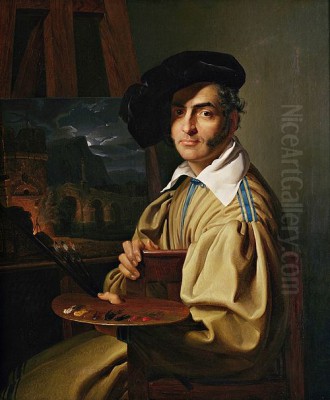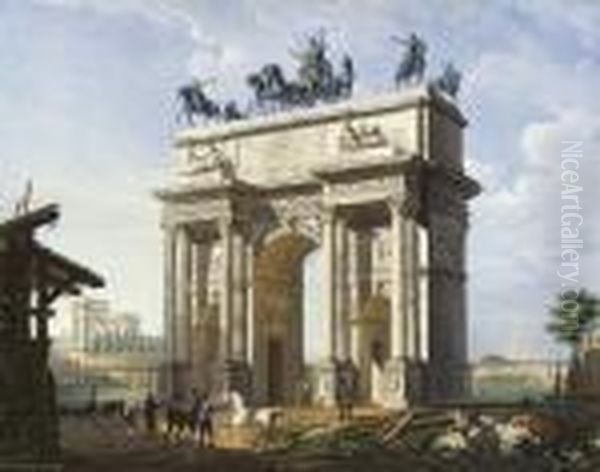
Giovanni Migliara stands as a significant figure in early nineteenth-century Italian art, a painter whose meticulous technique and romantic sensibility captured the landscapes, architecture, and historical imagination of his time. Born in Alessandria in 1785 and passing away in Milan in 1837, Migliara navigated the transition from Neoclassicism to Romanticism, developing a distinctive style that earned him considerable acclaim during his lifetime. His work, primarily focused on vedute (city views), architectural interiors, and historical genre scenes, offers a fascinating window into Lombard artistic culture in the decades following the Napoleonic era.
Early Life and Theatrical Beginnings
Giovanni Migliara's artistic journey began not in the quiet solitude of a studio, but amidst the dynamic world of the theatre. Born on October 15, 1785, in Alessandria, a city in the Piedmont region of Italy, he eventually moved to Milan, the vibrant cultural and artistic hub of Lombardy. It was in Milan that he pursued formal artistic training, studying at the prestigious Brera Academy (Accademia di Belle Arti di Brera).
A crucial formative experience was his apprenticeship under Gaspare Galliari (1761-1823), a noted member of a family renowned for their work in theatrical scene painting. Under Galliari's tutelage, Migliara honed his skills in perspective and architectural rendering, talents essential for creating convincing stage sets. He put these skills into practice, initially working as a scene painter at the Teatro Carcano in Milan.
His talent soon led him to a more prominent position at Milan's legendary opera house, the Teatro alla Scala. For approximately four years, Migliara contributed to the visual spectacle of La Scala's productions. This period undoubtedly deepened his understanding of dramatic lighting, spatial composition, and the evocative power of architecture, elements that would become hallmarks of his later easel paintings.
A Shift Towards Intimate Canvases
Around 1810, Migliara's career took a significant turn. Plagued by a serious pulmonary illness, the physically demanding work of large-scale scene painting became untenable. This health crisis forced him to redirect his artistic energies towards smaller, more intimately scaled works. This shift marked the beginning of the phase for which he is best known today.

He began producing exquisite small paintings, often executed in oil on canvas or panel, but also experimenting with watercolour. Demonstrating versatility, Migliara sometimes employed unconventional supports like silk or ivory, lending a particular preciousness to these works. His subject matter shifted primarily to landscapes, vedute, architectural interiors, and historical or genre scenes, often imbued with a nostalgic or romantic atmosphere.
These smaller works allowed Migliara to develop his characteristic style, marked by meticulous attention to detail, a refined application of paint, and a masterful control of light and shadow. His theatrical background likely informed his ability to create compelling atmospheres and dramatic spatial effects, even within confined dimensions. His paintings from this period quickly found favour with collectors and patrons.
The Vedute Painter: Capturing Italian Cities
Migliara excelled in the genre of the veduta, or view painting, a tradition particularly strong in Italy, famously mastered in the previous century by Venetian artists like Canaletto and Francesco Guardi. While indebted to these eighteenth-century masters, Migliara brought a distinctly nineteenth-century sensibility to the genre, blending topographical accuracy with a romantic mood.
His vedute often depicted famous landmarks and bustling urban scenes, particularly in Milan and Venice. He rendered architectural details with remarkable precision, capturing the textures of stone, the play of light across facades, and the intricate ornamentation of buildings. Unlike the often sun-drenched clarity of Canaletto, Migliara's views frequently feature more nuanced atmospheric effects, sometimes depicting twilight, overcast days, or the soft glow of interior spaces opening onto a cityscape.
Notable examples of his vedute include views of the Piazza del Duomo in Milan, capturing the grandeur of the cathedral and the life of the square. His depiction of the Arco della Pace (Arch of Peace) in Milan is significant not only as an architectural study but also as a reflection of the post-Napoleonic era's aspirations for peace. He also painted numerous views of Venice, such as the Veduta di Palazzo Ducale di Venezia (View of the Doge's Palace, Venice), showcasing his ability to handle complex architectural ensembles and watery reflections. Compared to his contemporary Francesco Tironi, another veduta painter, Migliara often achieved a finer, more jewel-like finish.
Historical Scenes and Romantic Sensibilities
Aligned with the broader European Romantic movement, Migliara demonstrated a keen interest in history, particularly the medieval period, and in scenes evoking past eras or contemporary life with a picturesque or anecdotal quality. His historical and genre paintings often share the same meticulous detail and atmospheric lighting found in his vedute.
Works like La presa del Castello di Prato (The Capture of Prato Castle) exemplify his engagement with historical subjects. These paintings were not grand historical narratives in the manner of his contemporary Francesco Hayez, the leading figure of Italian Romantic history painting, but rather more intimate, carefully staged scenes. They often focused on architectural settings as much as on the human figures within them.
His interest in genre scenes is evident in works like the Carnival of Venice, capturing the festive atmosphere and masked figures associated with the event. He also painted numerous church interiors, such as the Interior of the Church of San Satiro in Milan (sometimes referred to as Interior of the Duomo in sources, requiring careful identification). These interiors allowed him to explore complex perspectives and the dramatic interplay of light filtering through windows or illuminating shadowy recesses, reminiscent perhaps of the Dutch masters like Pieter Saenredam, known for his church interiors, or Johannes Vermeer for his handling of light in intimate spaces. This focus on historical and picturesque themes connects Migliara to the French Troubadour style, popular in the early 19th century, which favoured scenes from the Middle Ages and Renaissance rendered with precise detail, seen in works by artists like Fleury François Richard or Pierre Révoil.
Miniatures and Material Experimentation
Beyond his oil paintings and watercolours on traditional supports, Migliara also gained recognition for his miniature works. These small-scale creations, often depicting landscapes, town views, or natural scenes, further showcased his capacity for intricate detail and delicate execution. A significant collection of these miniatures is housed in the Museo Civico in his hometown of Alessandria.
His willingness to paint on materials like silk and ivory also sets him apart. These non-traditional supports required a high degree of technical skill and contributed to the precious, object-like quality of some of his smaller works. This experimentation reflects a certain refinement and perhaps catered to the tastes of discerning collectors who appreciated virtuosity and novelty.
Academic Recognition and Royal Patronage
Migliara's talent and growing reputation did not go unnoticed by the artistic establishment or by influential patrons. His skill in perspective, honed during his years as a scene painter and evident in all his work, led to a prestigious academic appointment. In 1822, he was named Professor of Perspective at the Brera Academy in Milan, the very institution where he had studied. This position solidified his standing within the Milanese art world and allowed him to influence a younger generation of artists.
His success extended to the highest levels of society. His detailed, often romanticized views of Italian cities and historical moments appealed greatly to the aristocracy and royalty. In 1833, his career reached a pinnacle when he was appointed Court Painter to Charles Albert of Sardinia, King of Sardinia-Piedmont. This royal patronage was a significant honour, confirming his status as one of the leading painters in the Italian peninsula at the time. His detailed, almost "photographic" precision, combined with romantic subject matter, resonated with the tastes of the elite.
Artistic Style: Precision, Light, and Romanticism
Giovanni Migliara's style is characterized by a unique blend of meticulous realism and romantic atmosphere. His draftsmanship was precise, his rendering of architectural detail exacting. He possessed a sophisticated understanding of perspective, allowing him to create convincing and often complex spatial illusions, particularly in his architectural interiors and cityscapes.
His handling of light was central to his art. He masterfully depicted the subtle gradations of light and shadow, whether capturing the bright sunlight on a Venetian canal, the cool illumination of a Gothic church interior, or the soft glow of lamps in an evening scene. This sensitivity to light contributed significantly to the mood and emotional resonance of his paintings.
While his precision might seem aligned with Neoclassical ideals, Migliara's choice of subject matter – medieval themes, picturesque views, romanticized historical moments – firmly places him within the Romantic movement. He represented a transition, moving away from the heroic and didactic aims of Neoclassicism, as exemplified by sculptors like Antonio Canova or painters like Andrea Appiani, towards a more personal, atmospheric, and often nostalgic vision. His work shows affinities with Northern European traditions, particularly seventeenth-century Dutch painting, in its attention to detail and light, yet filtered through a distinctly Italian sensibility and the emerging Romantic taste for the historical and the picturesque.
Relationships and Context
Migliara was an active participant in the artistic life of Milan. His friendship with the prominent Brescian architect Rodolfo Vantini (1792-1856) is documented. Vantini, known for designing the Cimitero Vantiniano in Brescia among other works, reportedly benefited from Migliara's connections and reputation, which helped promote Vantini's own work both in Italy and abroad. Migliara's death was deeply felt by friends like Vantini.
His work should be seen within the context of Lombard art in the early nineteenth century, a period marked by Austrian rule and a growing sense of Italian cultural identity that would feed into the Risorgimento. Milan, under the influence of the Brera Academy, was a major centre, fostering both Neoclassical holdovers and the burgeoning Romantic movement led by figures like Francesco Hayez. Migliara carved a distinct niche within this environment, focusing on genres that allowed for both technical virtuosity and romantic expression.
Legacy and Lasting Influence
Giovanni Migliara enjoyed considerable success during his lifetime. His paintings were sought after by Italian and international collectors, including members of the aristocracy and royalty. His academic position and court appointment attest to the high regard in which he was held.
His historical influence lies primarily in his contribution to the veduta genre in the nineteenth century, adapting the tradition of Canaletto, Bernardo Bellotto, and Guardi to a new romantic sensibility. He demonstrated that detailed architectural rendering could be combined with atmospheric depth and emotional resonance. His meticulous technique may have influenced later Italian painters specializing in detailed genre or architectural scenes.
His daughter, Theodolinda Migliara (1816-1866), also became a painter, though her reputation never matched her father's. Today, Giovanni Migliara's works are held in important public collections, including the Pinacoteca di Brera and the Galleria d'Arte Moderna in Milan, the Museo Civico in Alessandria, and other Italian and international museums. His paintings continue to appear at auction, appreciated for their technical skill, historical interest, and charming depiction of nineteenth-century Italy.
Conclusion
Giovanni Migliara remains a captivating figure in Italian Romantic art. Emerging from the world of theatrical design, he transformed his technical skills into a highly refined style of easel painting. His meticulously detailed vedute, atmospheric interiors, and romantic historical scenes captured the spirit of his age while showcasing his unique artistic vision. As a respected professor and court painter, he achieved significant contemporary success. More importantly, he left behind a body of work that continues to enchant viewers with its blend of precision, evocative light, and nostalgic charm, securing his place as a master of the intimate view and the romanticized past in nineteenth-century Italian art.